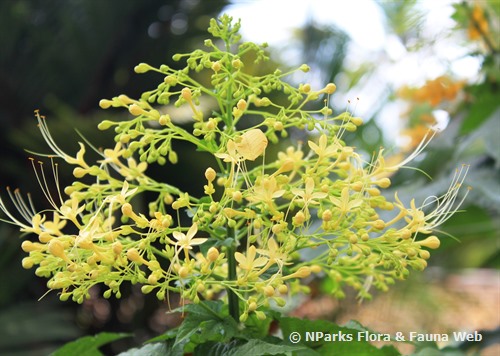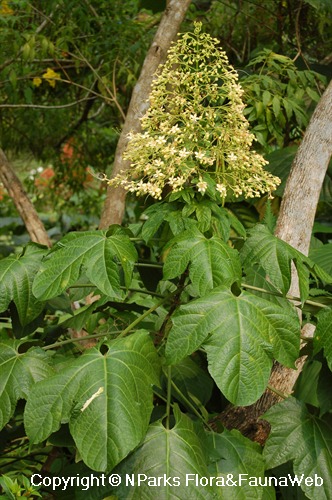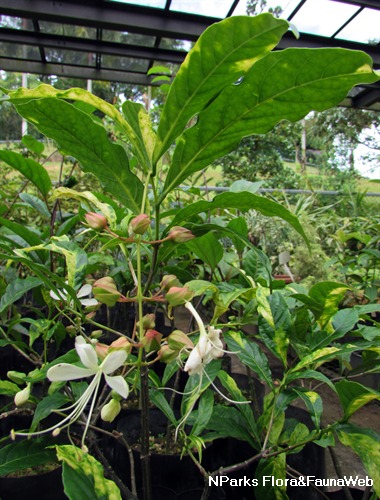
Back
Clerodendrum paniculatum 'Alba'
| Family Name: | Lamiaceae (Labiatae) |
| Common Name: | White Pagoda Flower |
21 Nov 2025 (James/Pauline) added species growth rate, marked as moderate
Name
Classifications and Characteristics
| Plant Growth Form | Shrub |
|---|---|
| Mode of Nutrition | Autotrophic |
Biogeography
| Native Distribution | Southeast Asia |
|---|---|
| Native Habitat | Terrestrial |
| Preferred Climate Zone | Tropical |
Description and Ethnobotany
| Growth Form | Evergreen shrub, able to grow up to about 1 - 2 m tall and 2 - 3 m wide. |
|---|---|
| Foliage | Large and lobed leaves, opposite arrangement, measuring up to 30 cm wide. |
| Flowers | Large terminal inflorescence (pagoda-shaped) of many green and white flowers, able to reach up to 45 cm long, flowers are 5-lobed and measures about 2 cm long, stamens and style extend beyond the petals. |
| Fruit | Fruit is a bluish-black drupe. |
| Etymology | Genus epithet Clerodendrum is from the Greek word "kleros" which means chance and "dendron" meaning a tree. Species epithet paniculatum refers to the arrangement of flowers in terminal panicles. |
Landscaping Features
| Desirable Plant Features | Ornamental Flowers |
|---|---|
| Landscape Uses | Parks & Gardens, Small Gardens |
Fauna, Pollination and Dispersal
| Fauna Pollination Dispersal Associated Fauna | Butterfly-Attracting |
|---|
Plant Care and Propagation
| Light Preference | Full Sun |
|---|---|
| Water Preference | Lots of Water, Moderate Water |
| Plant Growth Rate | Moderate |
| Rootzone Tolerance | Moist Soils, Well-Drained Soils |
| Propagation Method | Stem Cutting |
Foliar
| Mature Foliage Colour(s) | Green |
|---|---|
| Leaf Area Index (LAI) for Green Plot Ratio | 4.5 (Shrub & Groundcover - Dicot) |
Floral (Angiosperm)
| Flower Colour(s) | White |
|---|
Image Repository
Others
| Master ID | 531 |
|---|---|
| Species ID | 1827 |
| Flora Disclaimer | The information in this website has been compiled from reliable sources, such as reference works on medicinal plants. It is not a substitute for medical advice or treatment and NParks does not purport to provide any medical advice. Readers should always consult his/her physician before using or consuming a plant for medicinal purposes. |






.jpg)
